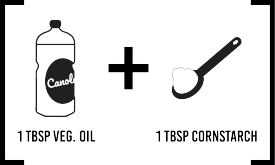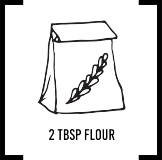Easy Homemade Playdough and the Science Behind It!
Materials you'll need
- Mixing bowl or cup
- Spoon or popsicle stick
- 1 tbsp Water
- 1 tbsp Salt
- 1 tbsp Vegetable Oil
- 1 tbsp Cornstarch
- 2 tbsp flour
- Food colouring

Step 1:
Gather all of your materials and make sure you have a clean surface to work on. The kitchen works best because flour and cornstarch like to fly around. Roll up your sleeves and get ready to start!
Step 2:

Step 3:

Now add in 1 tbsp of cornstarch into the bowl. When you start mixing, you may notice that it becomes tough to stir and clumps up the harder you try to mix it. This is because you've almost made oobleck! Oobleck is made when we mix water and cornstarch (both are now in our bowl!). The cornstarch is what is going to help our playdough clump and stay together.
Step 4:
Now is the time to add in any colours or sents that you want! We want to add it now because the solution that we have in our bowl is still a liquid. It is easy to mix two liquids together and have them fully mix. If we were to add the colour after adding in the flour, we are mixing a liquid with a solid and the colour won't blend uniformly. We would have to knead it for a long time.
Step 5:

Step 6:
Don't worry if your playdough wasn't perfect right away. THAT'S THE BEST PART! Now you get to show me a thing or two about science.
If your playdough is too crumbly, just add a little bit of water. I really mean a little bit, just wave your hand under the tap and then sprinkle the water off your fingers into the bowl. Just like if you washed your hands and went to flick the rest of the water at your friend.
If your playdough is still runny or sticking to the sides of the bowl while you're stirring, you just have to add a little more flour. Add a little bit at a time and mix. Check what your playdough looks like and think about what you need to add next.
You are done if when you mix your playdough, it is moving in one clump. Now just grab a little flour in your hands and start playing!
That's it! You've made your very own playdough and looked at some of the science behind a very common product. Remember to share what you did with us online at @uLethbridgeDE.
Back to At Home with Destination Exploration